General
The Rotherhithe Infirmary was built during 1873-1875 in Deptford Lower Road (renamed Lower Road in 1888) on a 2-acre site adjacent to the workhouse of St Olave's Poor Law Union. The Infirmary had a central administrative block, flanked by male and female ward blocks on each side which could accommodate 175 patients.
In 1877 it was enlarged. The workhouse closed in 1884 but the Infirmary remained, and was extended again during 1890-1982.
During the 1920s it was known as the Bermondsey and Rotherhithe Infirmary.
On 1st April 1930, following the abolition of the Boards of Guardians, it came under the control of the LCC, who renamed it St Olave's Hospital. Three operating theatres were installed by the LCC to enable it to become a general hospital treating both medical and surgical patients. The Hospital had 687 beds.
During WW2 the maternity block was severely damaged by a high explosive bomb. The Hospital was further damaged in 1941 by high explosive and incendiary bombs. An incendiary bomb hit the main linen and blanket store in the administration block, the centre of the Hospital. In August 1944 a V1 flying bomb exploded in Lower Road, damaging a third of the Hospital's buildings. In November 1944 a V2 rocket fell in the courtyard of the Hospital, causing severe damage, but amazingly no-one was killed. In 1945 another V2 rocket exploded behind Gomm Road, by the Nurses' Home, the fifth and last of these V weapons to strike the Lower Road area of Rotherhithe.
In 1948 the Hospital became part of the NHS, under the management of the Bermondsey and Southwark Hospital Management Committee, part of the South East Metropolitan Regional Hospital Board.
Much of the oldest part of the Hospital had been lost by the five direct hits by bombs during the war. The resulting loss in beds had reduced the nominal bed complement to 515, of which only 350 were staffed, mainly due to the lack of nurses and the need to respace the beds (a ward which previously held 37 beds now only held 20-22).
By 1954 the Hospital had 315 beds. Because of the difficulty in getting nursing staff, a campaign was launched to recruit foreign nurses. This proved successful and a veritable United Nations of nurses, some 14 nationalities, including German, Spanish and Italian, were employed. Among the Jamaican nurses were Seventh Day Adventists who, because of their religious convictions, stopped work at sundown on Fridays, which proved rather inconvenient in winter.
Visitors from the King's Fund found the Hospital very old, with no dominant point of entry, and located in a heavy commercialised area. It was indeed one of the oldest hospitals structurally (part of it was said to date back to 1790). Two of the main ward blocks were adorned with curious ventilation shafts dating back to the mid 19th century. One of the ward blocks had been provided with a sanitary tower by the LCC. The main corridor of the Hospital was narrow and there was a lack of uniformity within the buildings. The quality of signposting was poor (the staff had put up amateur signage). The Out-Patients and Casualty Departments were not busy.
In 1957 only three of the 12 wards had been modernised, including the new children's ward, which had seven single cubicles, two double ones and 10 ward beds. The children's ward replaced the pre-war Babies Ward, Boys Ward and Girls Ward but, with modern treatments, remained half-full. The Hospital had 519 beds, of which 313 were staffed. The wards were light and airy, and contained 25 beds each. The Out-Patients Department was housed in a large temporary building put up after the war. The X-ray Department was located in an empty ward.
In 1959 a Refreshment Pavilion was built at the cost of £1,400.
By 1961 the Hospital had 496 beds. In 1966 it became part of the Guy's Hospital Group, part of the South East Thames Regional Health Authority.
In the late 1960s the Hospital became the first general hospital to open its doors to psychiatric patients, when a Psychiatric Day Hospital with 50 places was established to be shared with Cane Hill Hospital. In 1973 a second Day Hospital opened.
In 1971 the buildings were upgraded at a cost of £200,000. The wards were upgraded in 1973.
In 1974, under another NHS reshuffle, the Hospital came under the administration of the Lewisham and North Southwark District Health Authority.
The kitchens were upgraded in 1977 at a cost of £20,000.
In 1979, despite the wards, operating theatre and kitchen facilities being improved, the District Health Authority decided to 'temporarily' close the Hospital to save £1.5m within the group. A new Day Centre for psychogeriatric patients, constructed at a cost of £40,000, remained unused. Services within the Hospital began to be run down and within the year all acute services had been transferred to Guy's Hospital (the philosophy at that time was that complex back-up services needed by acute patients would only be available in district general hospitals). Psychiatric patients were transferred to Guy's Hospital, while general medical patients were sent to Guy's Hospital and New Cross Hospital.
By 1979 only 40 patients remained in the Hospital, 30 of whom were psychogeriatric. They were eventually transferred to New Cross Hospital.
The 220-bedded St Olave's Hospital never reopened and finally officially closed in 1985.
Present status (May 2008)
The gatehouse survives, as does the Out-Patients building, which was converted into the 17-bedded St Olave's House Nursing Home, but this too is now threatened with closure (2008).
The rest of the vacated Hospital buildings became derelict and were demolished. The site was redeveloped in the 1990s and is now a housing estate - Ann Moss Way.
The St Olave's House Nursing Home, which opened in 1987.
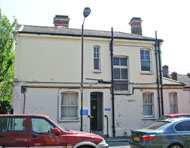
The gatehouse is now used by the South London and Maudsley NHS Trust (SLAM)
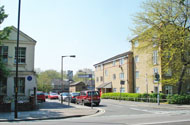
The gatehouse, shown on the left at the mouth of Ann Moss Way, contains a commemorative blue plaque to the actor Sir Michael Caine.
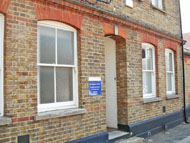
The old ambulance station is now used by SLAM.
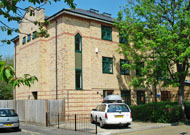
The Chaucer Community Resource Centre at 13 Ann Moss Way.

Signage for the Home, with the address added later.
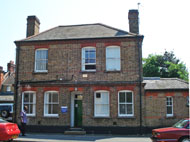
Another old building which is used by SLAM.
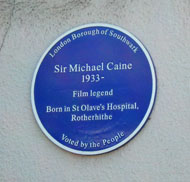
Sir Michael Caine, son of a fish porter, was born in the charity wing of the Hospital on 14th March 1933 as Maurice Joseph Micklewhite.

The new ambulance station
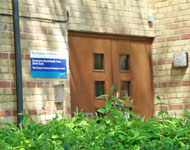
The entrance to the newly built Centre.
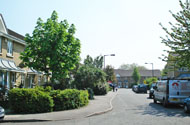
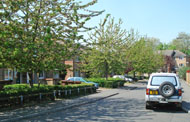
Housing in Ann Moss Way
http://hansard.millbanksystems.com
www.aim25.ac.uk
www.bermondseyboy.net
www.flickr.com (1)
www.flickr.com (2)
www.flyingbombsandrockets.com
www.geograph.com
www.nationalarchives.gov.uk
www.southwarkpct.nhs.uk
www.theyworkforyou.com
www.workhouses.org.uk
Return to home page